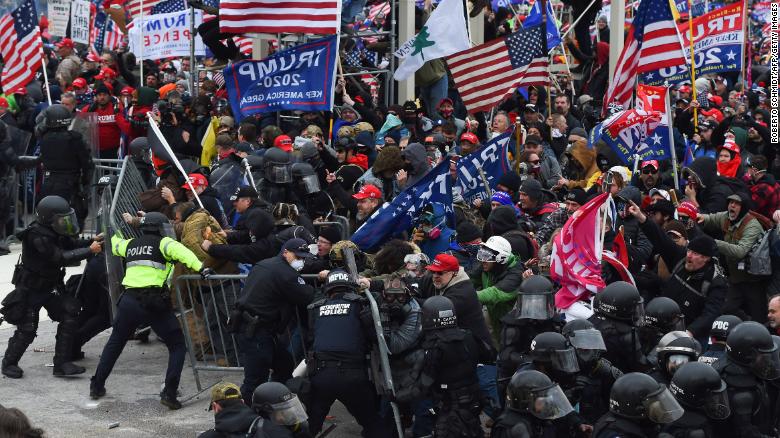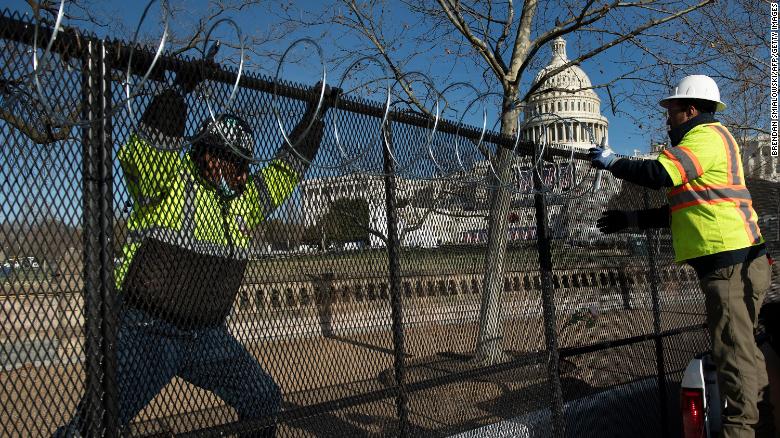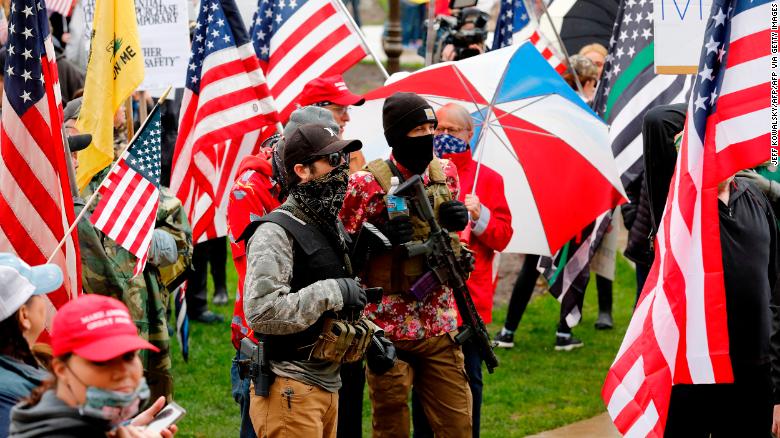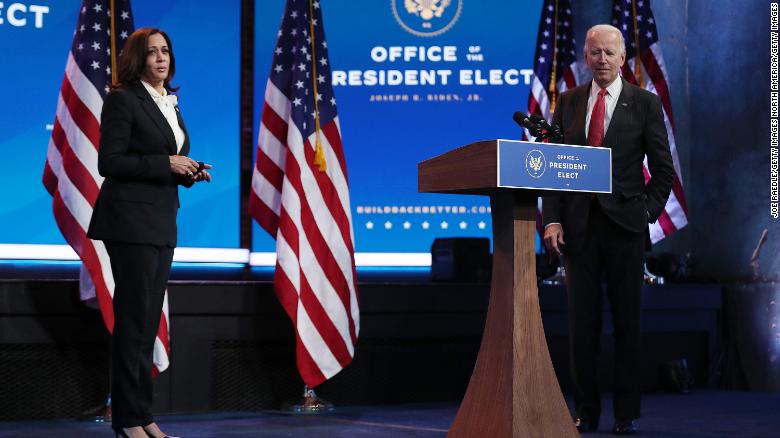The US Capitol is surrounded by fences and troops amid fear the January 6 riots could spark violence this weekend and leading up to Wednesday’s inauguration.
But experts worry the real threat may be what the attack unleashed for the long term.
“The plots of tomorrow are literally being hatched right now,” Oren Segal, vice president of the Anti-Defamation League’s Center on Extremism, told CNN.
Experts shared growing concern about chatter around a unifying message of people who feel wronged — by those in power, by the political system and by Big Tech.
They’re also worried that the numbers of potentially violent extremists are growing. Social media giants banned President Donald Trump and others over fears their posts would continue to spark violence, which the experts said has led to a sympathetic and growing audience at risk of radicalization.
Some who had communicated via Facebook, Twitter or even Parler are now on other platforms. Those include Telegram, where extremists and White supremacist channels have existed and spewed hate for years in channels largely unmoderated until just days ago.
On many of these channels, there is frequent praise of mass killers, tactical instructions and vile and disturbing radicalizing content being spread rapidly.
“Our moderators are reviewing an increased number of reports related to public posts with calls to violence, which are expressly forbidden by our Terms of Service,” Telegram spokesperson Remi Vaughn told CNN in a statement on Wednesday. Vaughn added: “We welcome peaceful discussion and peaceful protests, but routinely remove publicly available content that contains direct calls to violence.”
The search for ‘fresh blood’

Segal calls the Capitol attack a seminal moment and says it will have a major impact, even more than the country’s historically biggest catalysts for major anti-government activity.
“It ain’t Waco, it’s not Ruby Ridge, this is bigger than that,” Segal explains comparing January 6 to past events that sparked calls to action and inspired deeper distrust and sometimes hatred against the government. “This stuff impacts more people.”
In public and private chats there are common messages about plotting to “take back America” or rallying together against supposed censorship, according to Angelo Carusone, president and CEO of Media Matters for America. Carusone and his team have been tracking extremist language and posting in a variety of media landscapes.
“We saw these mass migrations from traditional platforms like Twitter and Facebook to a surge of activity on Parler, and then a secondary surge of activity onto platforms like Telegram as these intermediate groups started to build up redundancy in their communications,” he says.
“And that meant fresh blood,” Carusone says.
Fringe online spaces are now seeing far-right figures, hate-filled White supremacists, and racists who have clamored for civil war mix with QAnon conspiracists and ardent President Trump supporters who have listened to him for years and believe the election was stolen from them. And many are figuring out what to do next — and how to craft their messages.
In one neo-Nazi-focused chat, a member urged restraint in language to avoid alienating newcomers, Carusone said.
Disturbing content alone isn’t enough
The FBI said in a statement to CNN that while some of the content may be disturbing, authorities cannot take action on that alone.
“The FBI cannot open an investigation without a threat of violence or alleged criminal activity. However, when that language does turn to a call for violence or criminal activity, the FBI is able to undertake investigative activity,” the agency said.
Investigators could face a tougher task of finding some people who have been removed from the bigger platforms.
“It is more and more important to know where they’re going, especially if they’re moving even further and further behind the veil,” Carusone said. “If you lose track of them entirely, you lose that that information pipeline, you lose the ability to identify those indicators, which means it’s harder to prevent harm.”

Prevention efforts must go beyond mere barricades and officers, Carusone says.
“It’s actually the mechanisms that are radicalizing these individuals,” Carusone says. “It’s the algorithms that are helping connect people.
It’s the disinformation.”
None of the protests this weekend or at the inauguration will feature an actual Trump rally. Experts say that’s a good sign, along with the increased law enforcement presence in Washington, DC.
In many messaging apps and boards, some are calling for a boycott of events this weekend and the inauguration. Michael Edison Hayden, the Southern Poverty Law Center senior investigative reporter and spokesperson, says high-profile names and podcasters Mike Peinovich and Nick Fuentes have told their followers not to go to rallies. The ADL says that White supremacist Peinovich, known as Mike Enoch, and the far-right Fuentes have been rallying voices of discontent for years.
Though there still are some concerning messages out there, Hayden says he believes the probability of violence in DC is not as high as it was on January 6 — when there was a lot of online chatter, a major political event in the certifying of an election and a Trump rally.
Federal authorities are also tracking dozens of people who pose potential concerns of violence who may be coming to Washington for events around the Inauguration, according to a source briefed on intelligence shared among federal and local law enforcement.
Experts worry some people will turn to their state Capitols to express their anger. Hayden says posts of coordinates and maps of statehouses have been posted online. The FBI has received information indicating “armed protests” are being planned at all 50 state capitols in the days leading up to the inauguration, according to an internal bulletin obtained by CNN earlier this week.
What could happen next
A bigger concern for experts tracking hate and extremism online? What may happen after this weekend and the inauguration.
Segal said extremists might move cautiously in coming days, from both paranoia and knowing they’re being watched.
“It’s not before inauguration that we need to be concerned about them trying to spark another civil war — it’s after,” Segal told CNN.
Segal says it is helpful to look at the situation in Michigan last spring when thinking how things could unfold after the Capitol attack.
“The reopen protests ended up resulting in part in an attempt to kidnap the governor,” Segal explains.

Trump was very much a part of that, too. He repeatedly criticized Gov. Gretchen Whitmer about her Covid-19 restrictions before and after the news of the plot against her.
Experts note that at the protests against her moves, there too was a cross-pollination of people who showed up — self-declared militia members, anarchists, those with anti-government beliefs and anti-vaxxers.
Now, take those existing grievances and add lies about the election being stolen and the Capitol attack. That kind of kinetic energy is hard to stop, experts fear.
Heading ‘into a buzzsaw’
The extremism experts agree on several glaring points on how we got here and where we may be going. America is in the midst of a mass radicalization of sorts. The fire starter was not Trump, they say; he simply threw gas on the flames.
Seeing Biden inaugurated, a Black and South Asian woman as his Vice President, and then realizing that Trump is gone will fan the flames for those who will falsely claim the Biden administration is illegitimate, Segal warns.

Carusone says this is just the beginning of the country heading “into a buzzsaw” due to divisiveness, extremist actions and political rhetoric.
“Trump has gift-wrapped the narrative for the next four years,” Segal explains.
The experts worry about a false sense of security emerging if the country makes it through the inauguration without any violence. But what happens when the barricades come down? When National Guard troops leave? When tech platforms, the general public, and the media turn their attention to other issues?
The threat will remain, the experts say.
“All of those new people being brought into these communities creates new opportunity for expanding the ranks,” Carusone said. “There’s going to be a lot of new people … organized and exposed to a set of prescriptions that ultimately bring us back to the same place … leading up to the attack on the Capitol.
“Except in this case, it’ll be more of them.”
As reported by CNN
